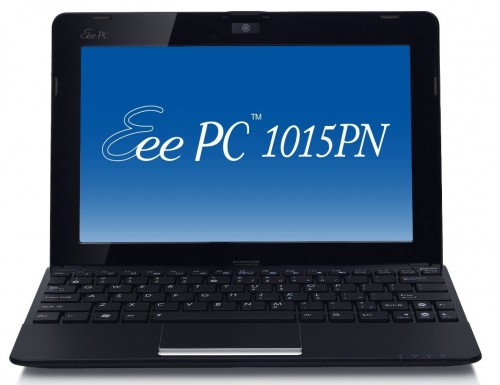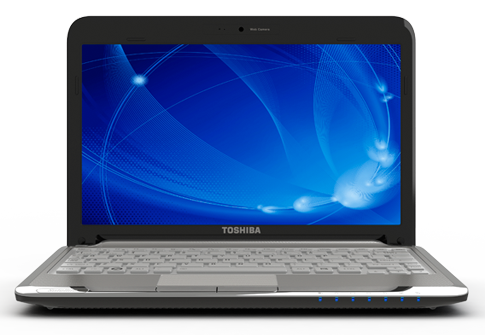Holiday Buyer's Guide: Notebooks
by Dustin Sklavos on November 15, 2010 9:00 PM EST- Posted in
- Laptops
- Guides
- Holiday 2010
Best Overall Netbook: ASUS Eee PC 1015PN-PU17 ($420)
While we don't have a whole lot of love here for Intel's Atom processor—it's dog slow and has seen virtually no evolution since its introduction—we do find there's a lot to like about its inclusion in the ASUS 1015PN.

The Eee PC 1015PN-PU17 is one of ASUS' myriad Atom-based offerings and part of their ever-growing Eee PC line, but it leverages every strength it conceivably can to produce what amounts to a sort of king of the netbooks: a dual-core Atom N550 processor coupled with NVIDIA's NG-ION graphics hardware. Naturally the netbook is Optimus-enabled, able to switch between the NG-ION and Atom's dire integrated graphics to improve battery life. The 1015PN also includes an increasingly rarefied matte screen, making it far more capable for the kind of outdoor use that netbooks should be ideal for.
If the Eee PC 1015PN has one Achilles' heel, it's battery life that comes up fairly short compared to the competition. The problem is that while it supports Optimus, you need to run the full Windows 7 Home Premium to get it... and ASUS ships the thing with Windows 7 Starter by default. Oops! So you lose dynamic GPU-switching (you can switch manually) but gain a much better netbook experience, at the cost of battery life. This is to be expected: there's a lot of extra power flowing through this system, but the payoff is in a machine that's more responsive and less aggravating to use than a basic single-core Atom netbook.
The rest of the 1015PN is bog standard for netbooks, with the usual 1GB of RAM and slow 5400-RPM hard drive. Bumping up to 2GB and Windows Home Premium will add another $100 or so to the total cost, and unfortunately ASUS continues to make it nigh impossible to actually upgrade the hard drive without tearing the system apart.
Netbook Runner Up: Toshiba T215D ($435)
If the idea of suffering through Atom in all of its glorious weaknesses doesn't sit right with you, Toshiba offers you another alternative: the AMD Nile-based T215D.

While Congo proved to be an exercise in "almost there," with Nile AMD finally proved they could bring the mayhem. The processors in this line are all derived from modern Athlon/Phenom II architecture, and they're consistently paired with the extremely capable Mobility Radeon HD 4225 integrated graphics.
What we're left with is a system that may not have the best battery life in the world (pushing just shy of five hours for typical use), but it's portable enough and gets along well enough in any other discipline. Even an NG-ION powered dual-core Atom is going to have trouble keeping up with a snappier Nile-based system, so if your usage pattern can't be squeezed into those narrow performance confines, the T215D is worth a look.
Technically some will complain that the T215D isn't a "netbook" since it uses an 11.6" chassis, but we're willing to stretch the definition. (Note that the higher spec Toshiba T235D we reviewed is larger still and sports a K325 dual-core processor in comparison to the K125 CPU in the T215D.) We wouldn't recommend any netbook as a powerful computing solution but rather as a "fast enough" alternative to Atom, and AMD's Nile offerings certainly fit that classification. The real question is whether you can live with the chromed-out silver aesthetics on the T215D.
When Portability Matters Most: ASUS 1015PED-MU17 ($326)
We've bashed on Atom performance plenty, but let's be clear: there's a niche that Atom fills perfectly well. That niche is the lightweight, inexpensive, long battery life netbook. Shop around and you can find cavalcade of similarly specced netbooks marching by, all tipping the scales at under 3lbs. and 8-10 hours of battery life, and priced to move starting at under $300. We'd recommend spending a bit more to get something with improved features and a larger battery life, though, which is why we return again to the ASUS Eee PC line. In fact, we ended up at the exact same 1015PN, this time without NG-ION. That means you keep the matte LCD but boost battery life up to 10 hours and save $100 in the process.
As an alternative to the ASUS 1015PN, you might also look at the Samsung N150-JP05 (JPxx). ASUS tends to get better battery life out of their netbooks in our testing, but the N150 also sports a matte LCD and has a different look that some will prefer over the ASUS clamshell design, and pricing starts at $300 instead of $325.










50 Comments
View All Comments
FATCamaro - Monday, November 15, 2010 - link
For most comparable system it is around 5-20% which isn't steep.Cuhulainn - Monday, November 15, 2010 - link
I'm 5'9" and weigh 168 lbs. This is in the normal weight range for body mass index.If I gained 20% more weight, I'd weigh 200 lbs and would be considered obese.
Just sayin'.
th3pwn3r - Saturday, November 20, 2010 - link
What in the world does BMI have to do with anything? Not to mention BMI is a failed investment that they won't let die. If you're judged as being obese just because you're a certain weight/height ratio it's stupid. Most body builders and fitness athletes are classified as obese through BMI.JarredWalton - Monday, November 15, 2010 - link
Well, here's steep for the MacBook Pro 15:- 2.4GHz Intel Core i5 (i5-520M or i5-450M?)
- 4GB (2x2GB) RAM
- 320GB 5400rpm Hard Drive
- SuperDrive
- NVIDIA GeForce GT 330M 256MB Graphics
- 15.4" Glossy 1440x900
- Secure Digital (SD) Card Slot
- iSight Webcam, Bluetooth 2.1+EDR
- 802.11n AirPort Extreme
- Mac OS X 10.6 Snow Leopard, 5.6 lb
Total price: $1707 online, $1800 from Apple.
I get more than that in every area with an XPS L501x, with a price of just $1000. Heck, we can toss out the Dell Precision M4500 as another comparison, which is really quite expensive since it's a mobile workstation:
Windows 7 Professional 64-bit
Core i5-520M (2.40GHz)
3 Year Basic Limited Warranty and 3 Year Next Business Day On-Site Service
NVIDIA Quadro FX 880M 1GB
2x2GB DDR3-1333MHz
15.6" HD+ (1600 x 900) Anti-Glare LED Display with Premium Panel Guarantee
320GB 7200rpm Hard Drive
8X DVD+/-RW
6-cell (60Wh) Lithium Ion Battery
Dell Wireless 1501 802.11b/g/n Half Mini Card
Dell Wireless 375 Bluetooth Module
Integrated webcam with microphone
Internal English Backlit Keyboard
Total price: $1750 (though granted that's with the current sale Dell is doing--which they do all the time)
There's no question NVIDIA charges more for Quadro 880M vs. GT 330M, though they're basically the same chip. Many of the other areas are a wash as well, but the upgraded LCD should be good (hopefully as good as the MacBook, but without testing I don't know). And of course, we're comparing 3-year warranty with on-site service to the standard 1-year Apple store warranty. This is about as close as the comparison gets.
For consumer oriented offerings, the Dell XPS and HP Envy 14 cost about half of the MacBook Pro 15 while delivering similar features. Yes, you can complain about the XPS aesthetics, but they do manage to deliver a lot for the price. So you're looking at Dell on the one hand making the XPS 15 with all the features that Apple MBP 15 has but worse aesthetics and a price of $1000. On the other, you can't actually find anything else with a decent LCD and build quality unless you move into business laptops (which not surprisingly carry a price premium), and even then Apple is priced higher for what you get.
I suppose the real question is to define "steep". 5% markup on Apple relative to Windows laptops if you include a student discount perhaps, but for average buyers the markup is at least 20%, and I'd qualify that as pretty steep considering the cutthroat nature of the computer industry.
FATCamaro - Tuesday, November 16, 2010 - link
Point taken. The XPS L501x is a winner vs the 15" MBP for value.MeesterNid - Tuesday, November 16, 2010 - link
Right, but if we really are talking mobile here then you have to consider the battery power and the weight of the machines. I'm not sure about the Dell, but the MBP is a fairly portable (not too heavy) device that gives you a fair amount of battery-powered computing time.awaken688 - Wednesday, November 17, 2010 - link
You are comparing the chips inside which is very important. But what about weight and battery.I'm still waiting to see a true side by side with the price comparison.
I still think the Apple 15 is overpriced, but some people value certain things much higher than others such a true portability (weight and battery).
Separate topic:
Long term battery test. I have 3 friends that just bought Apple laptops last year (2 MBP 15", 1 vanilla MacBook). Both are their batteries killed my PC laptop at the start. Now all 3 of their batteries can't even make it through a 1 hour meeting/class unplugged while using it.
bah12 - Wednesday, November 17, 2010 - link
Well certainly the 20% buys you some weight/battery life (hell 20% better get you something), but then subtract from those gains the hassle of OSX or Bootcamp, and the small gain is not worth it IMO. Its strictly a matter of personal opinion of course.Also all batteries degrade over time, as your experience shows Apple is not immune to this either. So replacement part cost should be a concern, and I'm sure you will see that Apple tax sneak it's way back in there too.
awaken688 - Thursday, November 18, 2010 - link
I can't comment on OSX. Most people that use Macs enjoy OS-X. I know Anand and company does. I still don't understand why someone besides the Sony Vaio Z can't produce a similar quality (speed, battery, weight, screen, usability) to a MacBook Pro. Yes I know it will be just as expensive, but we really don't even have a choice.Maybe Jared knows of one.
- 15"
- 1680x1050 Quality Matte Screen (no I don't want 1920x1080 or 1920x1200. I have a 1920x1200 Dell Precision Mobile Workstation now and that resolution is just too intense for that screen IMO)
- Core i5/i7
- 4GB+ Ram
- Decent GPU (I don't care about games. That is what consoles and desktops are for)
- Under 6 lbs.
- Less than 1" thick (although 1.1" is alright)
- Battery life under light surfing over 5 hours
I know this is a MacBook Pro basically, but is there anything out there that is like this other than Apple's offering?
8steve8 - Monday, November 15, 2010 - link
Anandtech is not entirely different, but the whole geeky media is over-obsessed with gpu performance on laptops. Very few people rely on a portable laptop for demanding 3d games, and the core i5/i3/i7 gpu is fine for non-cutting edge games like warcraft 3, and playing any sort of compressed video.Stressing gpu performance in the media forces the mfgrs to create laptops with discrete graphics, which means wasted volume, weight and energy.
case in point, even the new lenovo U260 seems to have allocated space for a gpu, in its 0.7" thick frame, and partially because of this, it can only fit a 29Whr battery.
http://shop.lenovo.com/gbweb/gb/en/learn/products/...
^ ^ you will see discrete graphics is an option... amazingly stupid trade-off on an ultra-portable.
apple stubbornly sticking to nvidia for GPU, at the cost of several years of cpu progress is not even worth a second of debate, especially on an 11" machine.
I'm not hating on anandtech, just the whole industry, reviews shape future designs, and as we are seeing now, even with good-enough-for-non-gamers igp performance, laptops of all sizes are being outfitted with discrete options. Stupid.